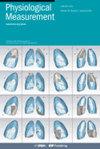通过石墨烯电纹身和电阻抗断层扫描诊断皮肤癌的无创方法。
IF 2.3
4区 医学
Q3 BIOPHYSICS
引用次数: 0
摘要
目的皮肤癌是全球确诊癌症中比例最大的癌症之一,也是最容易治疗的癌症之一。然而,这取决于早期诊断和正确的皮肤癌类型区分。目前,准确、快速和无创的早期检测方法还很有限。然而,有文献显示良性和恶性皮肤癌之间以及不同类型皮肤癌之间存在阻抗差异,这表明基于阻抗分化的方法可能很有前景。方法在这项工作中,我们提出了一种快速无创皮肤癌诊断的新方法,该方法利用了基于差异的电阻抗断层扫描(EIT)和石墨烯电子纹身(GET)技术。我们考虑了皮肤癌病变阻抗、大小、形状和相对于电极位置的变化,并评估了使用单个和多电极 GET(mGET)阵列的影响。结果表明,这种方法具有根据病变阻抗、大小和位置进行区分的潜力,但还需要其他技术来确定形状。 重要意义 通过这种方式,这项工作中提出的系统结合了 EIT 和 GET 技术,具有作为一种完全无创、快速的皮肤癌诊断方法的潜力。本文章由计算机程序翻译,如有差异,请以英文原文为准。
A non-invasive approach to skin cancer diagnosis via graphene electrical tattoos and electrical impedance tomography.
OBJECTIVE
Making up one of the largest shares of diagnosed cancers worldwide, skin cancer is also one of the most treatable. However, this is contingent upon early diagnosis and correct skin cancer-type differentiation. Currently, methods for early detection that are accurate, rapid, and non-invasive are limited. However, literature demonstrating the impedance differences between benign and malignant skin cancers, as well as between different types of skin cancer, show that methods based on impedance differentiation may be promising.
APPROACH
In this work, we propose a novel approach to rapid and non-invasive skin cancer diagnosis that leverages the technologies of difference-based electrical impedance tomography (EIT) and graphene electronic tattoos (GETs).
MAIN RESULTS
We demonstrate the feasibility of this first-of-its-kind system using both computational numerical and experimental skin phantom models. We considered variations in skin cancer lesion impedance, size, shape, and position relative to the electrodes and evaluated the impact of using individual and multi-electrode GET (mGET) arrays. The results demonstrate that this approach has the potential to differentiate based on lesion impedance, size, and position, but additional techniques are needed to determine shape.
SIGNIFICANCE
In this way, the system proposed in this work, which combines both EIT and GET technology, exhibits potential as an entirely non-invasive and rapid approach to skin cancer diagnosis.
求助全文
通过发布文献求助,成功后即可免费获取论文全文。
去求助
来源期刊

Physiological measurement
生物-工程:生物医学
CiteScore
5.50
自引率
9.40%
发文量
124
审稿时长
3 months
期刊介绍:
Physiological Measurement publishes papers about the quantitative assessment and visualization of physiological function in clinical research and practice, with an emphasis on the development of new methods of measurement and their validation.
Papers are published on topics including:
applied physiology in illness and health
electrical bioimpedance, optical and acoustic measurement techniques
advanced methods of time series and other data analysis
biomedical and clinical engineering
in-patient and ambulatory monitoring
point-of-care technologies
novel clinical measurements of cardiovascular, neurological, and musculoskeletal systems.
measurements in molecular, cellular and organ physiology and electrophysiology
physiological modeling and simulation
novel biomedical sensors, instruments, devices and systems
measurement standards and guidelines.
 求助内容:
求助内容: 应助结果提醒方式:
应助结果提醒方式:


